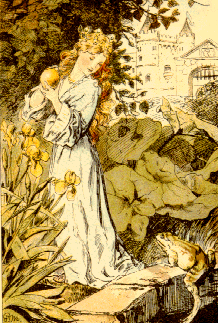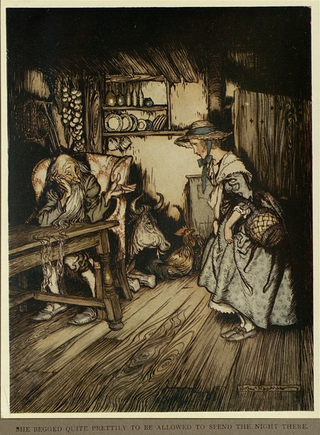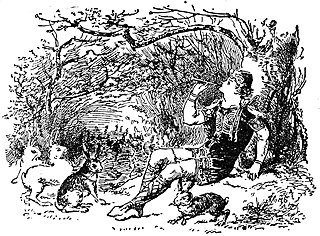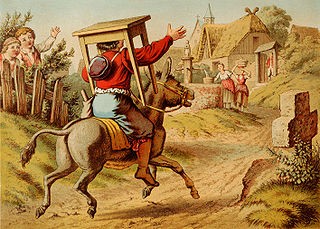
"Rapunzel" is a German fairy tale most notably recorded by the Brothers Grimm and it was published in 1812 as part of Children's and Household Tales. The Brothers Grimm's story was developed from the French literary fairy tale of Persinette by Charlotte-Rose de Caumont de La Force (1698), which itself is an alternative version of the Italian fairy tale Petrosinella by Giambattista Basile (1634).

"The Frog Prince; or, Iron Henry" is a German fairy tale collected by the Brothers Grimm and published in 1812 in Grimm's Fairy Tales. Traditionally, it is the first story in their folktale collection. The tale is classified as Aarne-Thompson type 440.
The Blue Light is a Brothers Grimm fairy tale about a soldier who finds a magical object that provides him a supernatural helper. Many of the features from Hans Christian Andersen's later work The Tinderbox and from the story of Aladdin and his magic lamp originate with this version. Other tales of this type include The Three Dogs and The Tinderbox.

Diamonds and Toads or Toads and Diamonds is a French fairy tale by Charles Perrault, and titled by him "Les Fées" or "The Fairies". Andrew Lang included it in The Blue Fairy Book. It was illustrated by Laura Valentine in Aunt Louisa's nursery favourite.
The Giant Who Had No Heart in His Body is a Norwegian fairy tale collected by Asbjørnsen and Moe.

Father Frost is a Russian fairy tale collected by Alexander Afanasyev in Narodnye russkie skazki (1855–63). Andrew Lang included it, as "The Story of King Frost", in The Yellow Fairy Book (1894).

"The Three Little Men in the Wood" or "The Three Little Gnomes in the Forest" is a German fairy tale collected in 1812 by the Brothers Grimm in Grimm's Fairy Tales. Andrew Lang included it in The Red Fairy Book (1890) as "The Three Dwarfs," and a version of the tale appears in A Book of Dwarfs (1964) by Ruth Manning-Sanders.

"Donkeyskin" is a French literary fairytale written in verse by Charles Perrault. It was first published in 1695 in a small volume and republished in 1697 in Perrault's Histoires ou contes du temps passé. Andrew Lang included it, somewhat euphemized, in The Grey Fairy Book. It is classed among folktales of Aarne-Thompson type 510B, unnatural love.

"The Hut in the Forest" is a German fairy tale collected by the Brothers Grimm. Andrew Lang included it in The Pink Fairy Book (1897). It is Aarne-Thompson type 431.
The Goat's Ears of the Emperor Trojan is a South Slavic fairy tale published by Serbian author Vuk Karadžić in 1870. Andrew Lang included it in The Violet Fairy Book. It was translated from a German version of Vuk Karadžić's Serbian Fairy Tales. The tale was also translated by John Naake as The Emperor Trojan's Goat's Ears and published in Slavonic Fairy Tales.
The Two Caskets is a Scandinavian fairy tale included by Benjamin Thorpe in his Yule-Tide Stories: A Collection of Scandinavian and North German Popular Tales and Traditions. Andrew Lang included it in The Orange Fairy Book.
The Enchanted Wreath is a Scandinavian fairy tale, collected in Benjamin Thorpe in his Yule-Tide Stories: A Collection of Scandinavian and North German Popular Tales and Traditions. Andrew Lang adapted a variant of it for The Orange Fairy Book.

The Old Witch is an English fairy tale published by Joseph Jacobs in his 1894 book, More English Fairy Tales. It is also included within A Book of Witches by Ruth Manning-Sanders and A Book of British Fairy Tales by Alan Garner. Neil Watkins has researched the story of ‘The Old Witch’. In "The Watkins Book of English Folktales" PP.55-60 Watkins records that the story was told by a nine year old girl called Nora to Ellen Chase in Deptford in 1892. Ellen Chase gave her copy of the story to Mrs Gomme, who then sent it to Joseph Jacobs. Watkins notes that “It is at once clear that the Gomme/Jacobs text is a radical revision of the original, rather than a slight brushing-up for publication.” Chase’s original notes were published in FLS News as ‘The Witch and her Servant’ and is re-produced in Watkins pp.58-59.
Anthousa, Xanthousa, Chrisomalousa or Anthousa the Fair with Golden Hair is a Greek fairy tale collected by Greek folklorist Georgios A. Megas in Folktales of Greece. Other variants were collected by Michalis Meraklis and Anna Angelopoulou.

"The King of the Golden Mountain" is a German fairy tale collected by the Brothers Grimm in Grimm's Fairy Tales.

Jesper Who Herded the Hares is a Scandinavian fairy tale, first recorded by Danish folktale collector Evald Tang Kristensen in the first volume of Æventyr fra Jylland. Andrew Lang included it in The Violet Fairy Book.
The Spinning-Woman by the Spring or The Kind and the Unkind Girls is a widespread, traditional folk tale, known throughout Europe and in certain regions of Asia, including Indonesia. The tale is cataloged as AT 480 in the international Folktale catalog.

"Puss in Boots" is a European fairy tale about an anthropomorphic cat who uses trickery and deceit to gain power, wealth, and the hand in marriage of a princess for his penniless and low-born master.

"The Wishing-Table, the Gold-Ass, and the Cudgel in the Sack" is a fairytale by the Brothers Grimm. The original German name is Tischlein deck dich, Goldesel und Knüppel aus dem Sack.
Maid Lena is a Danish folktale collected by author Svend Grundtvig. It features versions of the swan maiden, a mythic female character that alternates between human and animal shapes.












